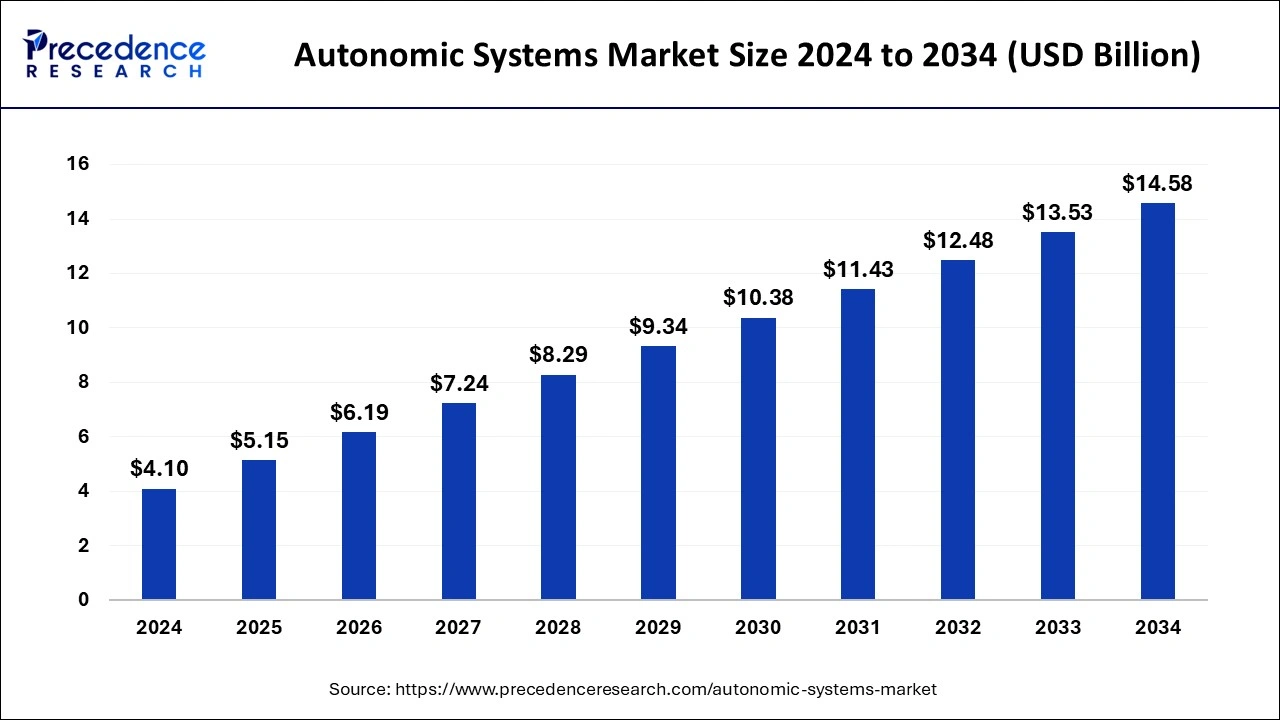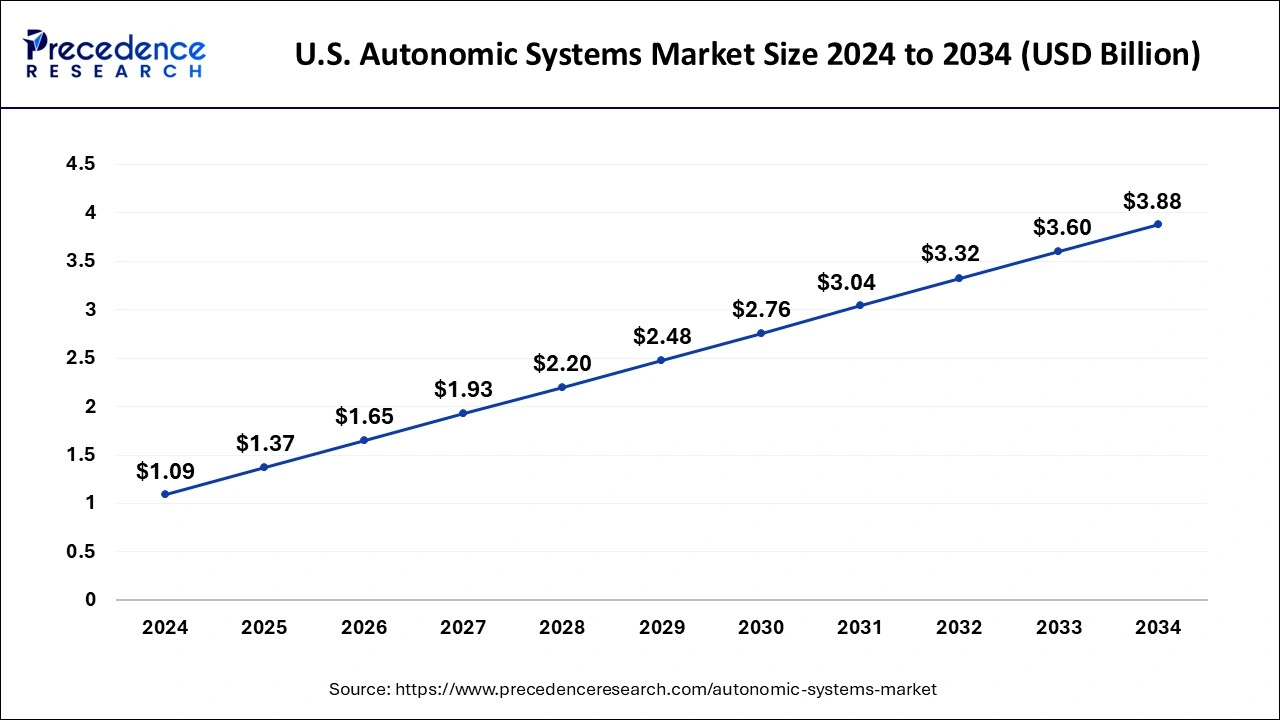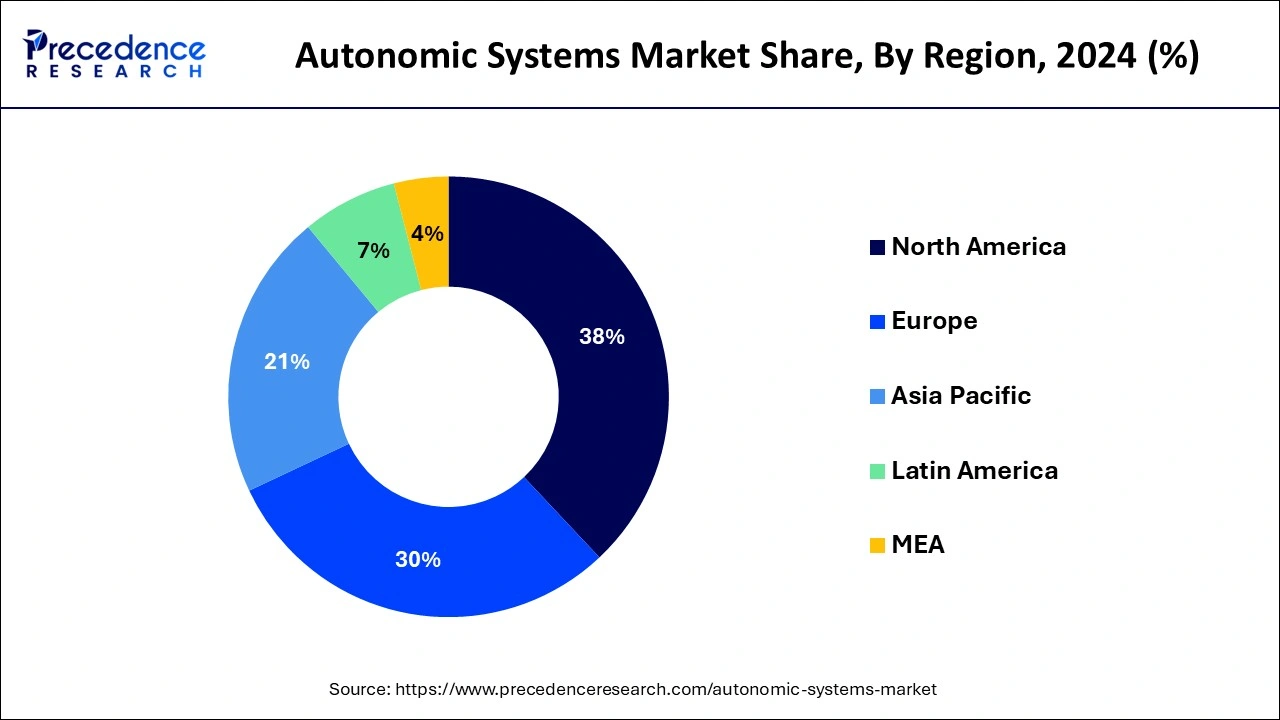Autonomic Systems Market Size and Forecast 2025 to 2034
The global autonomic systems market size was estimated at USD 4.10 billion in 2024 and is predicted to increase from USD 5.15 billion in 2025 to approximately USD 14.58 billion by 2034, expanding at a CAGR of 13.53% from 2025 to 2034.

Autonomic Systems MarketKey Takeaways
- In terms of revenue, the global autonomic systems market was valued at USD 4.10 billion in 2024.
- It is projected to reach USD 14.58 billion by 2034.
- The market is expected to grow at a CAGR of 13.53% from 2025 to 2034.
- North America held the largest share of the market, while carrying a 38% share in 2024.
- Asia Pacific is observed to witness the fastest expansion at a CAGR of 18.6% during the forecast period.
- By type, the Enterprise Software Application segment held the largest market share of 42% in the autonomic systems market in 2024.
- By application, the Information Technology (IT) segment held 29% of the market share in 2024.
U.S.Autonomic Systems Market Size and Growth 2025 to 2034
The U.S. autonomic systems market size was valued at USD 1.09 billion in 2024 and is projected to hit around USD 3.88 billion by 2034, growing at a CAGR of 13.54% from 2025 to 2034.

North America dominated the autonomic systems market with a 38% market share in 2024.The region hosts a plethora of key players, including technology giants, innovative startups, and established enterprises, which collectively contribute to the market's dynamism and growth. These players bring diverse expertise, cutting-edge technologies, and substantial investments into research and development, fostering innovation and pushing the boundaries of what autonomous systems can achieve. Moreover, North America benefits from continuous technological advancements across various industries, including IT, automotive, healthcare, and manufacturing, among others.
This technological prowess enables the development of sophisticated autonomic systems capable of addressing complex challenges and driving operational efficiencies. Furthermore, supportive government initiatives and policies in North America play a pivotal role in nurturing the growth of the autonomic systems market. Government agencies, research institutions, and industry bodies collaborate to create conducive environments for innovation, entrepreneurship, and the adoption of autonomous technologies.

Asia Pacific is expected to experience significant growth at a CAGR of 18.6% in the forecast period, as the region is witnessing a surge in industrial automation across various sectors, including manufacturing, automotive, and electronics. This trend is driven by the need for increased efficiency, productivity, and cost savings, leading companies to adopt advanced autonomic systems and technologies. Additionally, countries like China and India are emerging as major manufacturing hubs, attracting significant investments in research and development (R&D) and technological innovation. These investments are fueling the development of cutting-edge autonomic systems tailored to the specific needs of industries in the region.
Moreover, Asia Pacific benefits from a large and rapidly growing consumer market, driving demand for autonomous technologies in sectors such as transportation, healthcare, and agriculture. As urbanization and digitization continue to accelerate, there is a growing need for innovative solutions to address the evolving challenges faced by societies and businesses. Furthermore, supportive government policies, initiatives, and incentives aimed at promoting innovation and technology adoption further bolster the growth of the autonomic systems market in Asia Pacific.
Market Overview
The autonomic systems market refers to the segment of the technology industry focused on developing and providing solutions that mimic the self-regulating and self-healing capabilities observed in biological systems. These systems are designed to operate with a degree of autonomy, leveraging artificial intelligence, machine learning, and advanced algorithms to monitor, analyze, and optimize processes without direct human intervention.
In essence, autonomic systems aim to enhance efficiency, reliability, and resilience across various domains, including IT infrastructure management, healthcare, manufacturing, and transportation. The autonomic systems market is a rapidly evolving sector within the technology industry that focuses on creating self-regulating and self-optimizing systems inspired by biological processes.
These systems leverage artificial intelligence, machine learning, and sophisticated algorithms to mimic the autonomous behavior observed in living organisms. Autonomic systems focuses to enhance efficiency, resilience, and adaptability across various domains, including IT infrastructure management, healthcare, manufacturing, and transportation. By harnessing the power of automation and real-time data analysis, autonomic systems can detect anomalies, optimize performance, and make proactive decisions without human intervention.
This capability enables organizations to streamline operations, reduce downtime, improve resource utilization, and mitigate risks more effectively. As the demand for intelligent automation continues to grow, the autonomic systems market is poised for significant expansion, with innovations driving advancements in autonomy, intelligence, and adaptability across diverse industry verticals.
Autonomic Systems Market Data and Statistics
- In May 2023, the partnership between Autonomic and Ford represents a significant step forward in automotive technology and connectivity. By integrating cloud connectivity into Ford vehicles, users will have access to a range of innovative features and functionalities. For instance, the ability to unlock the car using a smartphone, predict maintenance requirements, and facilitate package deliveries directly to the vehicle's trunk demonstrates the potential for enhanced convenience and efficiency in automotive experiences. This collaboration underscores the increasing importance of cloud-based solutions in transforming the automotive industry and delivering more seamless and connected experiences to consumers.
- In July 2021, Google announced the launch of Autonomic Security Operations to enhance security operations through automation and advanced technology. Autonomic Security Operations appears to be a comprehensive solution stack designed to guide customers in modernizing their security operations. It likely includes a range of products, integrations, blueprints, technical content, and an accelerator program, all aimed at leveraging Google's technology stack and security expertise provided by Chronicle. This initiative is likely to streamline security processes, improve threat detection and response capabilities, and help organizations stay ahead in the ever-evolving cybersecurity landscape.
Autonomic Systems MarketGrowth Factors
- With the proliferation of digital technologies and the increasing complexity of IT infrastructure, there is a greater need for autonomic systems to manage and monitor various components such as networks, servers, and applications. Autonomic systems can help organizations effectively manage their IT environments and adapt to changing conditions autonomously.
- Organizations across various industries are under pressure to reduce costs and improve operational efficiency. Autonomic systems offer cost-effective solutions by automating repetitive tasks, reducing downtime, and optimizing resource utilization. This allows businesses to allocate resources more effectively and achieve better overall performance.
- The rise of cloud computing has accelerated the adoption of autonomic systems, particularly in cloud-based environments. Autonomic systems can dynamically allocate resources, scale infrastructure based on demand, and ensure high availability and reliability in cloud environments, supporting the growing needs of modern businesses.
- With the growing threat of cyberattacks and system failures, there is a rising demand for autonomic systems that can self-diagnose issues, detect anomalies, and take proactive measures to prevent disruptions. Self-healing capabilities are becoming increasingly important in maintaining system integrity and ensuring business continuity.
Market Scope
| Report Coverage | Details |
| Growth Rate from 2025 to 2034 | CAGR of 13.53% |
| Market Size in 2025 | USD 5.15 Billion |
| Market Size by 2034 | USD 14.58 Billion |
| Base Year | 2024 |
| Forecast Period | 2025 to 2034 |
| Segments Covered | By Type and By Application |
| Regions Covered | North America, Europe, Asia-Pacific, Latin America, and Middle East & Africa |
Market Dynamics
Driver
Demand for intelligent, adaptive, and self-managing systems
The autonomic systems market is propelled by the imperative need for intelligent, adaptive, and self-managing systems across various industries. In today's fast-paced and dynamic business environment, organizations face increasing complexity in managing their operations, IT infrastructure, and processes. Traditional approaches to system management are often time-consuming, manual, and prone to errors.
As a result, there is a growing demand for autonomic systems that can autonomously adapt to changing conditions, optimize performance, and self-heal in response to disruptions or failures. Intelligent autonomic systems leverage advanced technologies such as artificial intelligence, machine learning, and data analytics to analyze vast amounts of data in real-time.
By continuously monitoring and analyzing system behavior, these systems can identify patterns, detect anomalies, and predict potential issues before they escalate. This proactive approach to system management enables organizations to minimize downtime, improve reliability, and enhance overall operational efficiency. By adapting to evolving business needs and operating conditions, organizations can effectively meet customer demands, improve service levels, and drive competitive advantage. Self-managing autonomic systems are capable of self-configuration, self-optimization, and self-healing without human intervention. These systems can automatically configure settings, fine-tune parameters, and resolve issues in real-time, reducing the burden on IT staff and minimizing the risk of human error.
Self-healing capabilities enable systems to detect faults, isolate problems, and implement corrective actions to maintain system integrity and ensure continuous operation. Therefore, the demand for intelligent, adaptive, and self-managing systems is driving the growth of the autonomic systems market. Organizations are increasingly recognizing the value of autonomic systems in improving operational efficiency, enhancing resilience, and driving innovation. As businesses continue to embrace digital transformation and adopt new technologies, the importance of autonomic systems in enabling agile and responsive operations will only continue to grow.
Restraint
High implementation costs
The autonomic systems market faces a spectrum of restraints hindering its widespread adoption. One of the hindrances is the complexity of integrating autonomic technologies into existing infrastructures. This process often requires significant investments in time, resources, and expertise to ensure seamless compatibility and functionality. Additionally, the high implementation costs associated with deploying autonomic systems pose a barrier for many organizations, particularly smaller enterprises with limited budgets.
Additionally, Security and privacy concerns also restraint the growth, as the autonomy of these systems raises questions about data protection, unauthorized access, and potential vulnerabilities. Moreover, a lack of awareness and understanding about autonomic technologies among decision-makers and end-users inhibits their acceptance and adoption. Resistance to change within organizations, coupled with ethical and social implications surrounding the use of autonomous systems, further complicates their integration into various industries.
Opportunity
Growing demand for soundproof transportation
The autonomic systems market presents several opportunities for growth and innovation across various industries. One significant opportunity lies in the increasing demand for automation and efficiency in complex systems and processes. Autonomic systems offer the potential to streamline operations, reduce manual intervention, and optimize resource utilization in sectors such as manufacturing, healthcare, transportation, and energy. Furthermore, the proliferation of Internet of Things (IoT) devices and connected technologies creates fertile ground for autonomic systems to thrive. These systems can leverage real-time data from IoT sensors and devices to make intelligent decisions, automate tasks, and improve overall system performance.
Another promising opportunity stems from the rise of artificial intelligence (AI) and machine learning (ML) technologies. Autonomic Systems can harness the power of AI and ML algorithms to continuously learn from data, adapt to changing environments, and enhance their autonomy and decision-making capabilities. Moreover, the increasing focus on sustainability and environmental stewardship presents opportunities for Autonomic Systems to drive efficiencies in resource management, energy consumption, and waste reduction. By autonomously optimizing processes and minimizing environmental impact, these systems can contribute to sustainability goals and promote eco-friendly practices.
Additionally, as industries become increasingly digitized and interconnected, there is a growing need for robust cyber security solutions. Autonomic systems can play a crucial role in enhancing cybersecurity posture by autonomously detecting and mitigating threats, identifying vulnerabilities, and orchestrating response actions in real-time. Hence, the autonomic systems market stands poised for growth as organizations seek innovative solutions to address complex challenges and capitalize on the opportunities presented by digital transformation and automation.
Type Insights
The enterprise software application segment held the largest share of 42% in 2024. The main driver of the enterprise software application segment in the autonomic systems market is its ability to streamline and automate various business processes. Enterprise software applications offer businesses comprehensive solutions for managing their operations, including customer relationship management (CRM), enterprise resource planning (ERP), supply chain management (SCM), and human resource management (HRM). These applications enable companies to enhance efficiency, reduce manual errors, and optimize resource utilization. Hence, the enterprise software application segment plays a crucial role in driving the adoption of autonomic systems by offering sophisticated tools and platforms that enable organizations to achieve higher levels of automation, efficiency, and agility in their operations.
Application Insights
The Information Technology (IT) segment held 29% of the market share in 2024, driven by the need for agility, scalability, and reliability in modern business operations. The autonomic systems market is witnessing significant growth driven by the increasing complexity of IT environments, the demand for efficient IT operations, and the growing importance of cybersecurity. Autonomic systems offer solutions to address these challenges by automating tasks, optimizing resource utilization, and enhancing security measures.
Autonomic systems in the IT segment provide real-time monitoring, analysis, and response capabilities to proactively identify and resolve issues. Additionally, the rising frequency and sophistication of cyber threats have led to an increased focus on cybersecurity, further driving the adoption of autonomic systems. Hence, the Autonomic Systems market is characterized by innovation, strategic partnerships, and investments in research and development to meet the evolving needs of organizations across various industries.
Autonomic Systems Market Companies
- IBM Corporation (United States)
- Hewlett Packard Enterprise (HPE) (United States)
- Cisco Systems, Inc. (United States)
- Dell Technologies Inc. (United States)
- Google (Alphabet Inc.) (United States)
- Microsoft Corporation (United States)
- Oracle Corporation (United States)
- VMware, Inc. (United States)
- Nutanix, Inc. (United States)
- Red Hat, Inc. (United States)
- Fujitsu Limited (Japan)
- NEC Corporation (Japan)
- Hitachi, Ltd. (Japan)
- Huawei Technologies Co., Ltd. (China)
- Tencent Holdings Limited (China)
Recent Developments
- In September 2022, Seagate Technology Holdings plc has unveiled its latest innovation, the next-generation Exos X systems, representing advanced storage arrays driven by Seagate's sixth generation controller architecture. These systems prioritize data protection, integrating the ADAPT (Advanced Distributed Autonomic Protection Technology) erasure coding solution alongside Seagate's pioneering self-healing storage technology, ADR (Autonomous Drive Regeneration). This combination of cutting-edge technologies aims to fortify stored data against potential threats, ensuring enhanced reliability and resilience in storage environments.
- In October 2023, BT and Google Cloud forged a new alliance with a strong focus on advancing cybersecurity innovation. As part of this collaboration, BT will serve as a managed services delivery partner for Google's Autonomic Security Operations (ASO) product, which is built on Google Chronicle. This partnership underscores a shared commitment to leveraging cutting-edge technologies and expertise to enhance cybersecurity capabilities. By integrating Google's ASO solution into its managed services portfolio, BT aims to bolster its offerings and provide customers with robust security measures to safeguard their digital assets and infrastructure.
Segments Covered in the Report
By Type
- Data Management
- IT service management
- Networking
- Enterprise Software Application
By Application
- Government
- Banking
- Financial Services and Insurance (BFSI)
- Healthcare
- Information Technology
- Telecom
- Retail
- Others
By Geography
- North America
- Europe
- Asia-Pacific
- Latin America
- Middle East and Africa
 Get a Sample
Get a Sample
 Table Of Content
Table Of Content